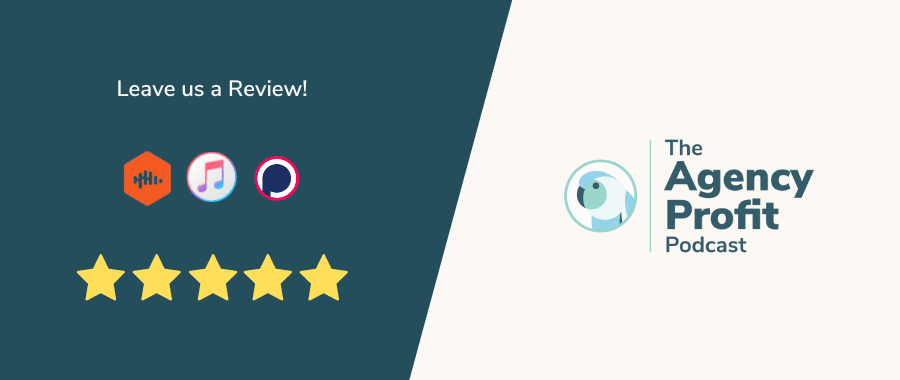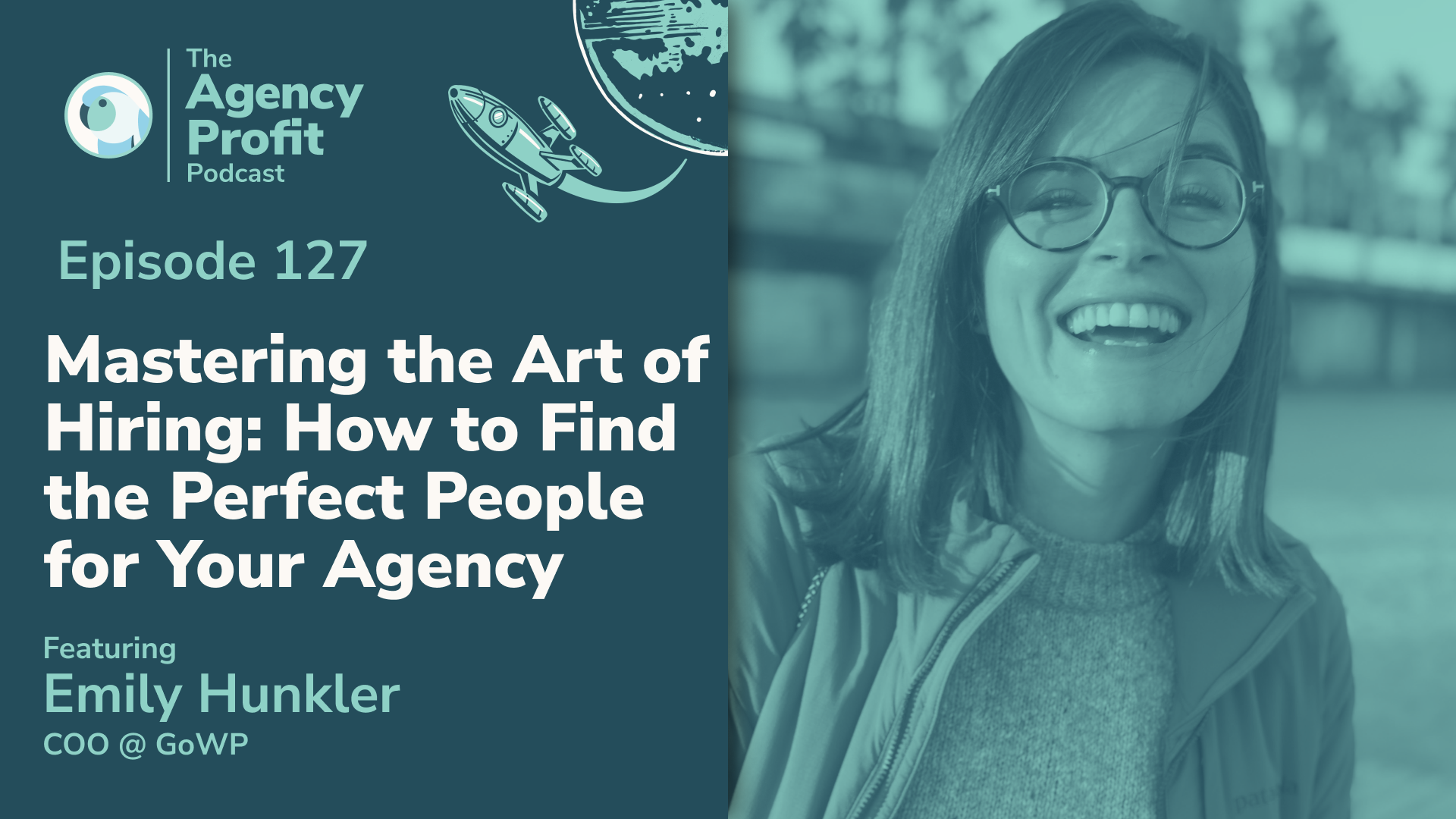This week, Marcel is joined by COO at GoWP, Emily Hunkler, to discuss the art of hiring. These include best practices for recruiting and working with contractors and freelancers in your agency.
About Emily Hunkler
Emily is the Chief Operating Officer for GoWP, a company helping agencies grow through their dedicated staffing and via white-label WordPress service development. An avid trail runner and co-leader of her local Trail Sisters group, in her spare time Emily also enjoys biking and hiking with the family! She lives in Athens, Ohio with her husband, Marc, their two young daughters, Ivette and Lydia, and the fastest dog in town, Otto.
Points of Interest…
- GoWP and its white-label offerings 1:35
- The future of contractors and freelancers 3:30
- Drilling down into timing, mistakes, and contract arrangements 5:54
- Number 1: Timing 7:50
- Number 2: Mistakes/Misconceptions 11:09
- Number 3: Arranging those contracts 17:53
GoWP and its white-label offerings
Today, folks, we’re going to unpack contractors and freelancers! Should you hire them? Should you not? How do you figure that out? And what are the keys to making those kinds of relationships successful? But first, what drove Emily into this industry and towards GoWP in the first place?
“I joined the go WP team five years ago as a Marketing Manager. GoWP was started by our founder, Brad Morrison, who lots of folks in this industry know. It was a solution to a problem, a need that wasn’t being met. He was an agency owner who started doing white-label services for other agencies that he made contact with. Website maintenance was just a big thing that agency owners didn’t want to deal with. They wanted to build sites.”
Designing sites and doing the marketing is all the sexy stuff, right? Nobody wants to maintain the backend, so to speak. Fair play to Brad, he found a universal pain point and niched down into that. He founded his website maintenance service, which worked month-to-month with 24-7 content updates for agencies and direct businesses.
After a couple of years, Brad and his team stopped serving direct businesses and just marketed to agencies. That’s when Emily arrived!
“Since then, our goal is just to help agency owners grow and scale. Our slogan is to ‘create happiness’. So, when we see a problem that several of our customers are having, or people are talking about in our community, we figure out how we can fill that gap.”
Hence the focus on creating solutions in terms of placement and hiring. GoWP has been early to a trend that I see picking up even more steam now than I ever imagined that it would. It’s this idea of providing a white-label backend team, or really providing a way for an agency to expand their service offering without having to bring all of the overhead.
It’s a way of bypassing all of the operational complexity of hiring that team internally.
The future of contractors and freelancers
Given my thesis on the future of how agencies are going to be structured, and it involving more white-label backend teams, I’m obviously interested in Emily’s take on where we’re headed with contractors and freelancers. What has she observed from her client base? What is she hearing from agencies that she’s working with in terms of their appetite for this kind of help?
“I think you’re spot on with that direction. What agency owners need is that elastic team… There’s a rollercoaster that comes with it, right? There’s either a feast or famine.”
Exactly. As an agency owner, we’ve all experienced times when you just can’t fathom taking on another project because your pipeline is so full. And then there’s a time when you’re just hoping and wishing that you don’t have to lay off team members because you don’t have any projects in the pipeline.
This is often the pendulous scenario of having a team of full-time hires. You really must maintain the revenue in order to support that. However, if you have the leeway to build these “elastic teams”, surely that’s preferable?
“Whether that’s with freelance and contractors, whether that’s through partnering with other agencies that specialize in different areas that you do, it’s definitely a trend we’re seeing. Agencies have customers that come to them because they specialize in building e-commerce sites, but they want to run PPC campaigns. So, what do you do?”
To Emily’s point, do you refer them to an entirely different agency that perhaps builds e-commerce sites? But what if you potentially lose that customer to that other agency down the line? Alternatively, do you contract a PPC specialist? Or, do you reach out to a contact well-versed in PPC and use them on a white-label basis while servicing your customer under your brand?
Either way, having more elasticity in your team gives you the opportunity and the resources to grow and perhaps diversify, or move laterally with a view to niching down.
“We have developers, copywriters, designers, virtual assistants. We would love to have a network of sales development representatives, PPC campaign managers, and SEOs. That way, when an agency owner needs a specialist, or needs someone on a contract basis, they don’t have to go through a month’s long process to find that person in order to fulfill a service that a customer needs now.”
Drilling down into timing, mistakes, and contract arrangements
Now that we know what GoWP does, and where having these elastic teams can be beneficial, there are three things I want to drill down on.
- When is it appropriate to do this? What is the context where it makes sense to bring in freelancers and contractors or bake that into your model versus building an in-house team?
- Common misconceptions held by agency owners attempting to undertake this route, or any mistakes/negative experiences we could perhaps learn from.
- The different ways to arrange those contracts and competition mechanisms. Given there are so many different ways to set up an engagement with a freelancer/contractor, is there a way of determining which way is best? Do you pay them by the hour, by project, or a defined period of time?
So, with that, let’s dive into point 1…
Number 1: Timing
When should an agency be thinking about freelancers and contractors versus an in-house team? Is there a decision-making process in that assessment? After all, having an in-house team is a big investment upfront. Not only are you looking at a hiring pipeline, before onboarding and making them a true team member, but you’re also hedging your bets that your chosen unicorn is just going to hit the ground running and keep on going! That’s seldom the case.
So, in Emily’s experience, is there an optimum juncture? In terms of taking someone on, you can always contract them for a project and then onboard them if that project goes well and you see them fitting into your work culture. If things during the project nosedive, or there’s a culture clash, then you haven’t invested time and money onboarding them from the offset.
“You really have to know, if you’re doing a full-time hire, that this is someone you want fully integrated into your team for a long time – in order for that kind of investment to make sense.”
Utilization is the other consideration. If you’re thinking about a full-time hire, what is going to be the cost of the fluctuation and utilization for this person? This pivotal thing isn’t given enough consideration. Another thing is the forcing function of a freelancer’s hourly rate is higher than it would be if I had a full-time employee who was fully utilized. That, I think, is a really good forcing function for you to have good pricing hygiene.
For context; imagine you use a freelance resource for a certain type of work for six months – until you really get to a place where you’re like, “OK, we’re selling this, we can generate the pipeline, and we know we have the work to justify a full-time person.” Well, then you actually benefit from the full-time hire. Why? Because ideally it brings your hourly cost down; you’ve reached that critical mass. However, you’ve priced in more margin than you needed.
Now, you’ve actually increased your profitability! So you’re getting a real advantage from that hire beyond some of the other advantages that are more subjective. This is an objective profitability improvement because you’ve priced yourself at a place where you can support that work with a freelance resource.
Number 2: Mistakes/Misconceptions
Moving on to other concerns, such as misconceptions, or bad experiences. Has Emily threaded any repeat issues her GoWP clients might have experienced around freelancers?
“Number one is communication. One of the huge benefits of working with a contractor, or freelancer, is that it can be super efficient, right?”
Picture the scene: you’ve got your project scoped out, you just need someone to tackle the tasks. If you have it all organized well with a project management tool, things should go smoothly. All of it can go down the pan, however, unless there’s effective communication between you and your freelancer or contractor.
One of the biggest pain points Emily has witnessed, is when a client is working with a contractor on Upwork or Fiverr. You know this story; you hand off the project and you don’t hear aaanything. For weeks maybe, right? Until, suddenly you get the work, but you still don’t know what’s going on. You don’t know what the progress is. So, lack of communication is a big one.
In her experience, it’s something she and her team discuss constantly internally and with their network of freelancers. Daily updates are key.
“The way our business model works is agencies get a set number of hours per week with a contractor on a monthly basis. So you’re working 10, 20, 30 hours a week with the same contractor, month to month. We tell them all the time, ‘Whenever you’re working on on a client’s work, give an update’.”
An update can be something as simple as “Hey, I’m clocking in for the day, this is what I’m working on.” Then, when you’re done, just give a heads-up with what you covered that day and what you plan to do the following day. It doesn’t have to be convoluted or verbose. In the absence of rudimentary communication, resentment can start to foment, followed by concern, conflict, and all the bad stuff that doesn’t need to happen. More importantly, it’s hard to recover from.
Another repeat stumbling block Emily sees in terms of mistakes is a reluctance to hand over work to someone an agency owner hasn’t sourced or vetted themselves. More on that old chestnut, plus the importance of SOPs, Process documentation, scope, and a healthy level of introspection from 13:20 minutes ***
Number 3: Arranging those contracts
I have a pricing framework, that looks at value and risk. The latter is really the big consideration here. When you’re trying to decide between, “Am I going to buy your hours? Or am I going to pay you a flat fee per month or a flat fee for this project?” there is a negotiation of risk happening. Who’s taking on the risk in this engagement?
Asking a freelancer to take a flat rate for the project is risky for them. Just asking them to give you a price for what you tell them the scope is, is great. It takes a lot of risk off of you. However, if you’re not very good at scoping, and you don’t give them realistic expectations about the scope (or it constantly changes), then there’s a really high probability of expectations being missed. It’s equally probable that said freelancer won’t want to work with you again…
The flip side of that? If you pay by the hour, then you’re taking on more risk. And so, I think it’s important to get an understanding of what the nature of this work really is. How new is it to us? How likely are we to be able to predict the scope of what’s going to happen? And how likely is the scope to change?
It’s worth bearing in mind that, sometimes, there are certain types of work inherently iterative, and changing the scope as you go is a part of the process. To get this right, you must keep those things in mind when looking at those different arrangements. That way, everyone has a balanced risk profile and you’re not having to fight against the contract in order to get the right result out of the contract. More musings on this from 19:25 minutes***
Key takeaway…
By way of a recap, GoWP has historically been white-label for agencies, helping expand their team by giving them access to Emily’s team. As a result, these agencies can scale up faster!
“Growing your agency beyond yourself and your in-house team isn’t as daunting or prone to failure as many agency owners think.”
Oftentimes, the excuses I hear as to why an agency owner *MUST* take on full-time hire, whatever the reservations may be, there’s actually just another issue underneath that. The full-time hire is a compensation mechanism because an agency owner’s SOPs or processes aren’t that clear, so they can’t simply hand it over to a freelancer.
I would encourage anyone who is listening to this (and hasn’t already checked out because they think freelancers aren’t a good fit for them for the above reasons) to assess these concerns. Do they, perhaps, lead back to an operational principle that is fundamental to the business that might not be working? So, once again, document your processes so you can hand them over to a freelancer/VA if and when you need to. Be prepared.
Some of the most profitable agencies that we’ve audited are really, really deliberate about what their core strengths are and what they build an internal team around. They’re really good at staying disciplined, stating, “No, we’re going to use partner agencies, or referral partnerships, or freelancers to still offer things to our clients that they want and that they’re asking for. This won’t add a bunch of operational drag and complexity to our business, and add an arm are we’re not really passionate about, and we’re not excellent at.” They can frankly admit that it’s not the core thing that makes them amazing.
As the industry has really leaned into specialization over the last decade, we’ve become very fragmented. Using white-label services is a way for agencies to remain disciplined in that specialization. There are a lot of advantages to it, while still being able to provide that more holistic service to clients.
In short, you can have your cake and eat it too with this model. And we’re seeing it in the numbers. It is leading to more profits.
See more from Emily Hunkler…
Did you learn anything new from this episode? Let us know in the comments below! We have helpful blogs designed to bolster your agency profitability, such as How To Calculate Your Billable Employee Cost-Per-Hour.
Our next installment of #APP, on November 15th, will see Marcel joined by Robert Patin. Our previous APP blog – Episode 126 with Chris Moore – can be viewed here…
Avid #APP Listener?!
We would be eternally grateful if you could leave us a review…

Agency Profitability Tool Kit
If you’re looking for more resources to help you improve your agency’s profitability, check out the Agency Profitability Tool Kit. It’s full of templates and checklists used when consulting clients. This helps them improve profitability by over 100% in under 60 days.
Fill out the form below for your copy!




0 Comments